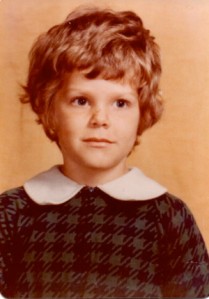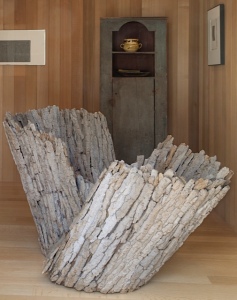
Twirl
It always starts with a dream. In the first one, she and her father have to retrieve a dead baby from the bottom of a well. As she matures as an artist, the baby begins to look like her middle son, my husband, as a toddler. He no longer needs to be rescued. Now he just needs tending to—to be fed, or warmed, or to have his diaper changed. But it’s always obvious to her that this child in her dream has been neglected. It’s a sign, a “sweet signal from her unconscious,” she says, that it’s time to get back to work.
And work she does. For the last 35 years, Terry Albright has gone to her studio daily from 9 am to noon. She knows that by showing up art will get made.
Her most recent show, “So You Know…” and the one she says will be her last, was at Skinner’s Auction House in Boston. The second floor of this open, bright gallery space was testament to Albright’s dedication and talent. Each sculpture was thoughtfully arranged often times on antique furniture, as it would have been seen in someone’s home.
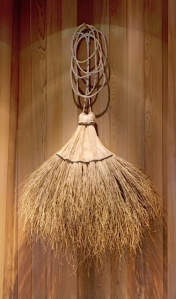
Whisk
Most of Albright’s sculptures evoke images found in nature. But these are not driftwood pieces you’d find in a kitschy seaside shop. Albright transforms Mother Nature’s bounty into stunning abstract compositions.
Her earlier pieces, usually constructed out of bittersweet vine, bark or grasses, are large and striking. There’s “Whisk,” made of phragmites and rawhide, and inspired by her hair. It’s an oversized pony tail–in the vein of Claes Oldenburg–but organic, feminine, and delicate. And “Twirl” an intertwined, trunk-like construction of pine bark is reminiscent of a tête-à-tête chair or two contra dancers the moment their eyes catch before they spin down the line.
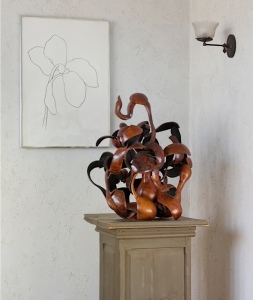
Bloom
After working with bark for over a decade, Albright saw some giant gourds growing out of her friend’s compost pile on Cape Cod. Their curves caught her attention. She started growing her own. She’d harvest, dry and cure them in her garage. She would then cut, stain and fasten these moldy, pungent “shards” as she calls them into refined and polished sculptures.
“Ripple” is a massing of blonde-colored gourd shards fastened with the lightest touches giving the sculpture a weightless feel. It evokes a pile of seaweed but is elegant and graceful. “Tarbaby”—made of tree-grown gourds from the Dominican Republic–could be a tower of black mussels clinging to a rock. It is totemic and airy. In “Bloom” the leather-dye stained shards seem to float and arc like Henri Matisse’s dancers in “La Danse.”
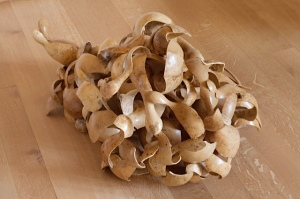
Ripple
Albright committed herself to becoming a fine artist later in life. She started at Massachusetts College of Art and Design, Mass Art, when she was 36 years old. Before that she’d been busy raising her three sons and completing her undergraduate degree from Harvard University’s Extension School. Mass Art was a commuter school with much younger students and “lots of attitude” she says. She’d sit in the back of class and not make waves. The other students were hungry—they’d come from schools where they were the best artists. “I was Lady Bountiful who was being supported by my husband,” she said, “I lived in a suburb.”
To prove herself, she knew that she needed to start working. She thought, “If I don’t take these next years and start working on my own it’s all going to be, Oh Yah, I did that four years ago.” She said too many women do that. They don’t stick with their plans.
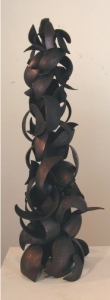
Tarbaby
So she forced herself to. She had a studio and made herself go in there and be an artist—even if she didn’t feel like one.
Her first project was called, “Mountain of Seven Deadly Sins”—a six-foot-high sculpture inspired by Pieter Bruegel’s “Tower of Babel.” This large mountain made by dripping semi-hardened plaster over chicken wire, and bittersweet and wisteria vines was fitted with alcoves and clay figures of Sloth, Greed, Envy, Lust, Anger, Gluttony, and Pride. It took over a year to build. She displayed it at her local church. When she brought it home it was too big to get into the house. She put it outside where it fell over in a storm and broke. She took it to the dump.
Then in 1987, after an operation, she couldn’t make art for six months. But she made herself go to her studio every day. She kept a notebook. She set a time limit. “You are going to stay here. I don’t care what you are going to do but you are going to stay here,” she said to herself. She realized, later, that it was in those six months—and the commitment of going to her studio–when she finally thought of herself as an artist.
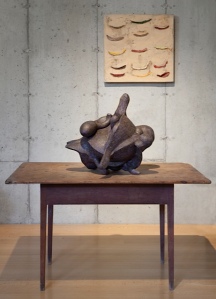
Birth
Since then she has been exhibited in galleries and museums all over Massachusetts, New York City and Paris including numerous solo shows as a member of Boston Sculptor’s Gallery.
Albright’s newest sculptures are also made of gourd shards but instead of being ethereal, like her earlier ones, these are opaque and biomorphic. “Birth” is an unformed being wrestling its way into shape. “Screech” could be a creature stepping out of the primordial soup stretching its limbs–made from the neck of the gourd–and reaching for the light. Both demonstrate the evolution of Albright’s vision–one that continues to emerge and re-form.
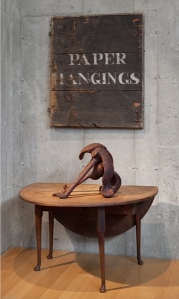
Screech
When Albright’s been productive, and working in the studio, she doesn’t have the baby dream. It’s only when she has not been feeding her artistic self that the dream appears. So when she has it, she finds a way back into her studio and starts working. When asked which artists inspire her she responds, “People who just go do it.”








